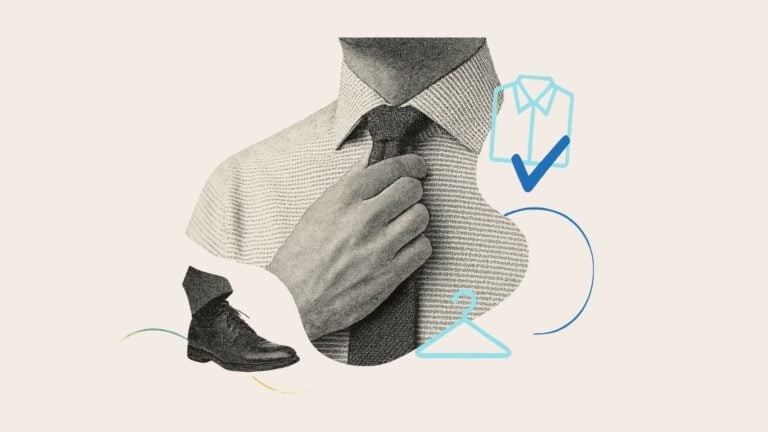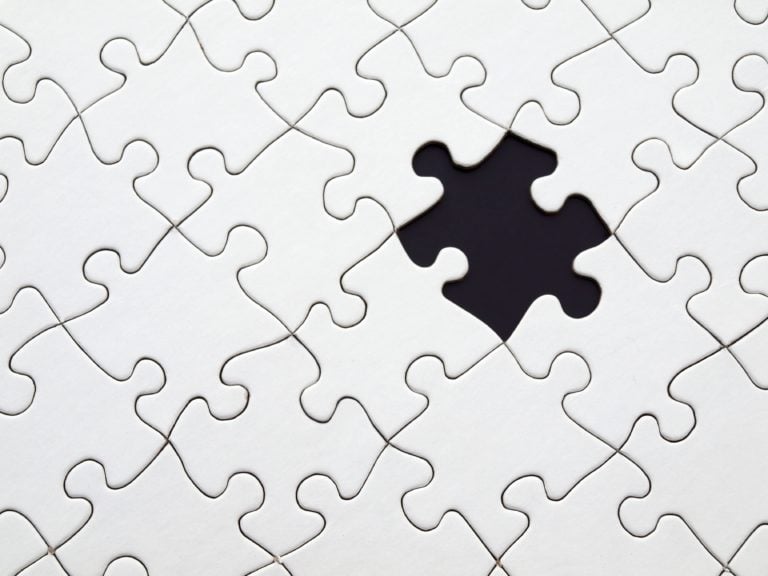Business casual sounds simple…until you have to dress for it. Here’s what it actually means, plus simple tips and outfit ideas to help you get it right.
Everyone seems to have their own take on business casual, which can make it hard to know exactly what works.
It can change by company, industry, or even location. If you’re unsure where the line is between too casual and too formal, you’re not alone.
So, what does business casual really mean today? Let’s break it down.
The Watercooler EP 01: Business Casual Dress Code
Join Jessica and Tod for a brief conversation exploring the essentials of business casual attire. Hear their insights on how to navigate this popular dress code in a modern workplace.
What Does Business Casual Really Mean?
Business casual is the middle ground between dressing up and dressing down. It’s neat, but not overly formal. You should aim for a clean, put-together, and workplace-appropriate look, without needing a full suit or heels.
Usually, business casual means skipping the tie, leaving the jeans at home, and grabbing a button-down, blouse, chinos, or dress shoes. But what counts as business casual really depends on your company, industry, role, or even what country you work in.
The key is to feel comfortable, but still look like someone who represents the company well. Your outfit should show you’re part of the team and ready to get to work.
Pro Tip
Need to Implement a Dress Code in Your Business? 👍
Connecteam’s all-in-one employee management app makes implementing a business casual dress code a breeze, providing customizable communication tools for sharing guidelines and visuals with your team.
Plus, Connecteam’s feedback and survey tools encourage open communication, allowing you to address concerns, answer questions, and consider suggestions from your employees.
Get started with Connecteam for free today!
What is Business Casual For Women?
For women, business casual is all about combining comfort with a clean, professional look. Staples like blouses, dress pants, midi skirts, and simple dresses are all solid picks. Closed-toe flats, loafers, or low heels usually work well too.
Stick to pieces that fit well and aren’t too bold. Bright colors and patterns are fine, but try to avoid anything too sheer, short, or tight. A blazer or cardigan can pull the look together, especially in more formal settings.
Think of it as dressing in a way that shows respect for your role, while still feeling like yourself. When in doubt, go for simple and structured.

Stick to the following:
- Top: Blouses, dressy short-sleeved or tank tops, turtlenecks, sweaters, cardigans, neutral or solid-colored tailored dresses, knee-length or midi dresses.
- Bottom: Pencil skirts, knee-length skirts, dark jeans, dress pants, khakis, corduroys, or slacks.
- Shoes: Flats, low heels, loafers, or oxfords.
What is Business Casual For Men?
For men, business casual usually means chinos or dress pants with a button-down shirt or polo. Add a belt and clean shoes, like loafers or oxfords, and you’re set.
You don’t need a blazer, but you can always take it off if you need. Stick to solid colors or simple patterns. Avoid graphic tees, athletic wear, or anything too worn out.
The goal? Comfortable, confident, and appropriate for the kind of work you do and the people you work with. Remember, it’s always better to be overdressed than underdressed.

Try to go for the following:
- Top: Neutral-colored short-sleeved button-down shirts, polos, button-up or collared shirt, blazer, sweaters.
- Bottom: Chinos, khakis, slacks, dark jeans.
- Shoes: Oxfords, loafers, leather shoes.
What is Business Casual For a Job Interview?
Job interviews are all about first impressions, and business casual is often the safest bet when you’re not told exactly what to wear. It strikes the right tone: professional, but approachable.
That doesn’t mean dressing like you already work there. Instead, aim to look just a little more polished than everyday workwear. You’re showing respect for the opportunity, without going overboard.
Think of business casual for interviews as your “meet-the-team” outfit. It should feel like you’ve made an effort, but not like you’re heading into a boardroom.
If you’re unsure how far to go, it’s always okay to ask the hiring manager or recruiter what’s expected. That shows you’re thoughtful and prepared.
What Not To Wear
When it comes to business casual, some things might be too casual. It can be hard to know where the line is if you’re not sure what counts.
Here’s a list of things that don’t usually fit the business casual dress code to help:
- Graphic tees or large logos: keep your look clean and simple
- Ripped or distressed jeans: work isn’t the time to be trendy
- Athletic wear or sweatpants: save them for the gym
- Flip-flops or casual sandals: go for closed-toed shoes instead
- Crop tops, tank tops, or low-cut blouses: wait for after work to rock these styles
- Shorts or mini skirts: even if it’s warm out, these are too informal
- Tennis shoes or casual sneakers: find shoes that are comfortable but still professional
- Bold prints or flashy accessories: try to keep the focus on you, not your outfit
- Clothing that’s too tight or too baggy: choose pieces that fit well and let you move comfortably
Still unsure what business casual looks like? Try out our game to test your knowledge!
Business Casual Emoji Dress Code Game
Drag and drop clothing emojis to see if they’re appropriate for business casual attire.
✅ = Appropriate for business casual ❌ = Not appropriate for business casual
Business Casual Items
Not Business Casual Items
Tips to Get It Right
Business casual can mean different things in different workplaces, which is exactly why it’s confusing.
But once you understand the basics, it gets easier. Here are a few helpful tips to make sure you’re dressing the part without overthinking it:
Pay attention to company culture
The easiest way to figure out what business casual looks like in your workplace? Look around. If your team leans more dressed-up or leans more relaxed, use that as your guide.
Keep it simple
Go for simple pieces with solid colors, clean lines, and a good fit. Once you know your workplace’s vibe, you can add more personality with colors, patterns, or accessories.
Find your ‘fit
It helps to have two or three go-to outfits that you know work. Something that’s clean, fits well, and makes you feel confident. That way, you know exactly what to wear for days when you’re rushing out the door.
Comfort is key
You’re at work for hours, so your outfit should let you move and focus. Business casual doesn’t mean stiff. Just leave the sweatpants at home and go for things that are easy to wear but still look intentional.
Don’t be afraid to ask
If you still have questions about how to dress for business casual at your workplace, ask your manager or refer to your employee handbook. Chances are, your coworkers are happy to share what’s considered normal at your job.
Why Clear Dress Code Guidelines Matter at Work
When dress code expectations are unclear, it creates more work for everyone. Employees hesitate, managers repeat themselves, and small issues can turn into bigger distractions. A well-communicated policy helps everyone stay focused, look professional, and feel confident in what they’re wearing.
Confusion slows things down
If your team isn’t sure what qualifies as business casual, they’re likely to ask questions, make guesses, or get it wrong. That puts pressure on managers to step in and clarify, often multiple times a week. A clear policy reduces back-and-forth and keeps daily operations running smoothly.
The way your team dresses reflects your business
Whether they’re meeting customers, working on a job site, or walking into a client’s office, your team sends a message without saying a word. Consistent appearance builds trust, while mixed signals can leave a negative impression. A simple, shared standard keeps your brand looking sharp.
Your team needs clear, visual examples
Dress code rules need to be easy to understand and access. A short written policy isn’t always enough. Adding photos, do’s and don’ts, or quick mobile access can help your team get it right the first time, without needing reminders.
Getting dress codes right doesn’t have to be complicated. With a little upfront clarity, your team knows what’s expected and can focus on the work ahead.
The Bottom Line On Business Casual Dress Codes
Getting business casual right isn’t about following a strict formula; it’s about showing up in a way that fits your role and reflects your company’s culture. A little consistency goes a long way.
If you’re managing a team, keeping expectations clear and accessible makes things easier for everyone. When everyone’s on the same page, things just run smoother.
If you’re looking for a simple way to share dress code guidelines, send reminders, or store policies in one place, Connecteam can help.
It gives your team quick access to what they need, right from their phones, so everyone can focus less on guessing what to wear, and more on showing up ready to work.
Try Connecteam for free today!





